Taonius
Richard E. Young and Katharina M. Mangold (1922-2003)- Taonius borealis
- Taonius pavo
- Taonius belone (Chun, 1906)
Introduction
Species of Taonius are large squids (up to 660 mm ML) with long, slender terminal fins (as seen in the video still frame below) and hooklike teeth on largest club suckers. They are found circumglobally in the midwaters of the open ocean. An AVI format video clip of this animal is available at Cephalopods in Action.

Taonius pavo in the cockatoo position. © Michael Vecchione.
Brief diagnosis:
A taoniin ...
- with large, claw-like suckers in the medial two series on the club manus.
- with long, lanceolate, terminal fins.
Characteristics
- Tentacles
- Tentacular clubs with enlarged suckers that bear one or two large, central, hook-like teeth.*
- Distal 2/3 of tentacular stalk with two series of suckers and pads.
- Terminal pad on club with 2-3 suckers separated from dactylus suckers by narrow "neck."
- Head
- Eyes large, bulge from head, anteriorly oriented.
- Eyes large, bulge from head, anteriorly oriented.
- Funnel
- Funnel valve absent.
- Funnel organ: Dorsal pad with three round, fat papillae.
- Mantle
- Fins
- Terminal, lanceolate, very long and narrow; anterior insertion on gladius.
- Terminal, lanceolate, very long and narrow; anterior insertion on gladius.
- Photophores
- Two ocular photophores: Medial photophore large, crescent-shaped; lateral photophore small, crescent-shaped within concavity of first.
- Arm tip photophores absent.
*Unique in family.
Comments
Characteristics are from Voss (1980).

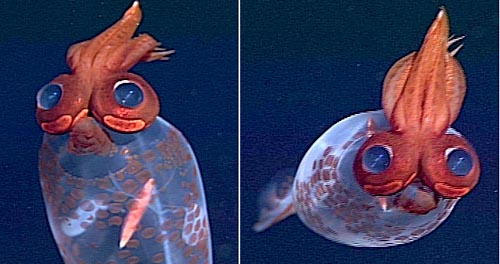
Figure. These insitu pictures of a Taonius-like squid, possibly T. borealis. were taken by an ROV of the Monterey Bay Aquarium Research Institute off California at 34°25.79'N, 127°31.63'W. The near parallel (i.e. forward) orientation of the hemispherical eyes is a feature that is shared with subadult and adult Taonius. Note the large ocular photophores, the very slender, spindle-shaped digestive gland and the heavy pigmentation of the head and brachial crown. © MBARI 2001 http://www.mbari.org/rd/midwater.
Nomenclature
Contributed by Patrizia Jereb and Clyde RoperChun (1906) named Toxeuma belone from the Indian Ocean at 10°08'S, 97°14'E on the basis of a single specimen of 51 mm ML. Lane (1957) pointed out that the generic name Toxeuma was preoccupied and proposed the name Belonella belone. Nesis (1972) maintained a generic separation between Belonella and Taonius based in part on his observation of the different consistency of the tissues (gelatinous in Taonius and leathery in Belonella). Belonella and Taonius were synonymised by Voss (1980), even though some authors did not accept this action(e.g., Nesis, 1987, Okutani, 2005). The identity/ validity of Chun's species, however, was long considered uncertain; ongoing research (Voss, pers. comm.), supporting previously published data (Nesis, 1987, Voss, 1988, Voss et al., 1992b) and working hypotheses (Young and Mangold, 2008), strongly indicate that T. belone should be synonymised with T. pacificus (the latter species name obtained by synonymising Belonella (pacifica pacifica, Nesis, 1972) with Taonius). Thus, the new combination is derived, Taonius belone (Chun, 1906), the specific name belone having priority.
Life history
As in Sandalops, species of Taonius go through a stage while in upper mesopelagic depths, in which the stalked eye has a nearly tubular shape (Young, 1975). The bottom of the eye is covered by two large photophores, one of which is strongly bilobed.

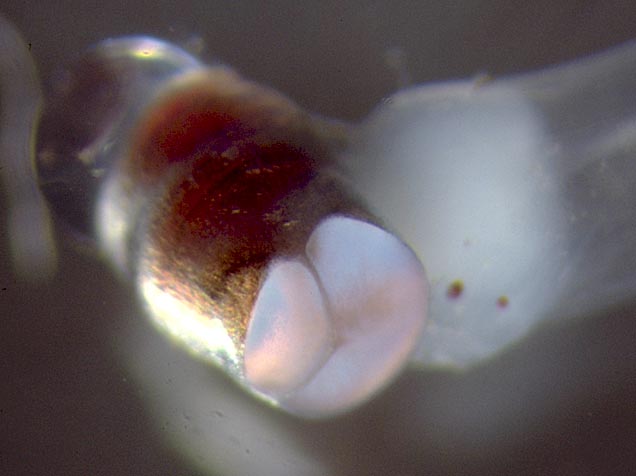
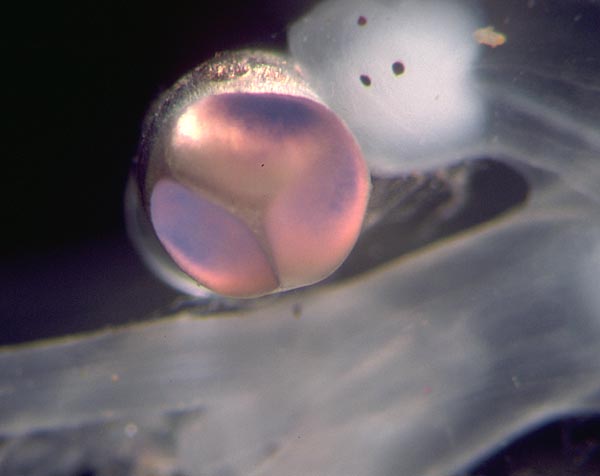
Figure. Ventral-oblique (left) and ventral (right) views of a tubular eye of a juvenile T. pavo, off Hawaii. Photograph by R. Young.

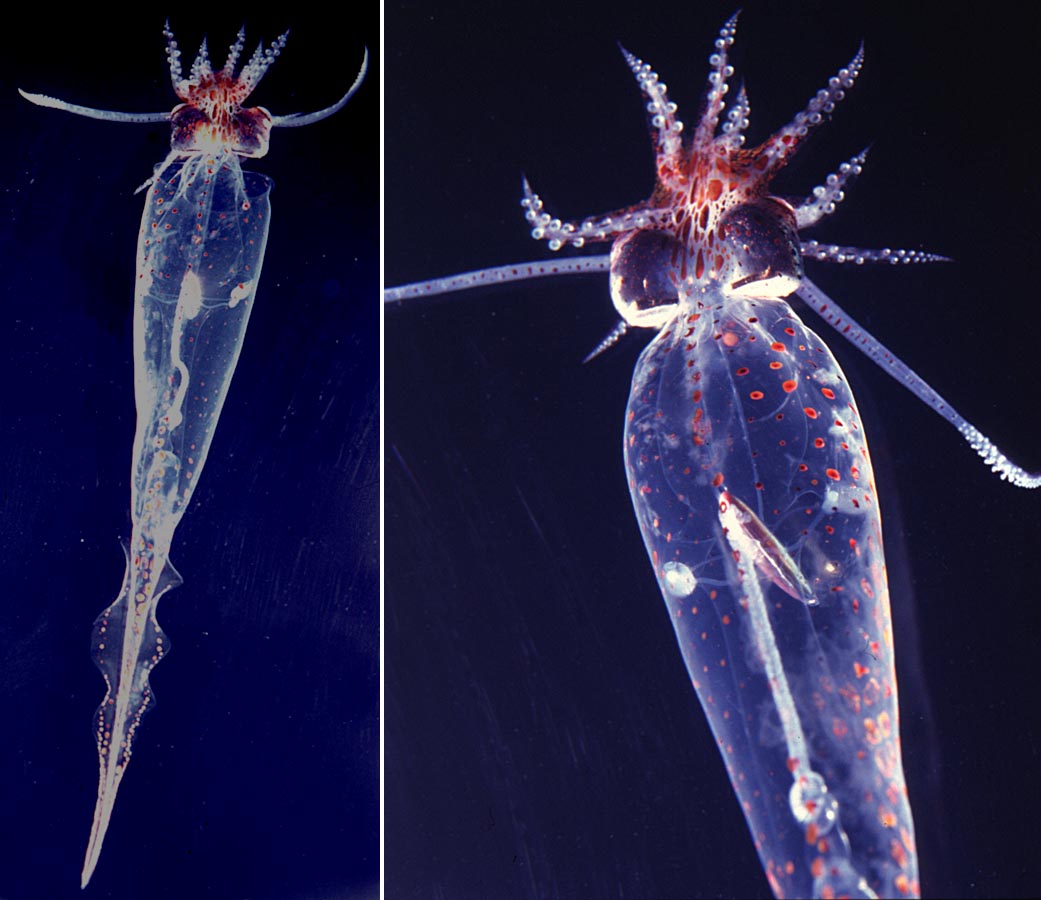
Figure. Dorsal view of a young Taonius (left) and a dorsal view of the anterior end of this squid (right), taken off Florida from a submersible of the Harbor Branch Oceanographic Institution. The eyes are just beginning the transition to a hemispherical shape. Large photophores appear to cover he posterior surface of the eyes. Photographs taken by E. Widder/HBOI.
Paralarvae of T. pacificus from Hawaiian waters have been identified. they are distinctive among cranchiid paralarvae from these waters in the near lack of chromatophores.


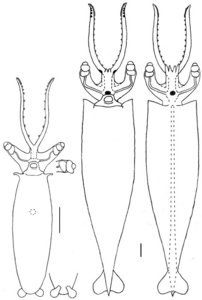
Figure. Paralarvae of T. pavo, Hawaiian waters. Thumbnail (far left) - Illustration shows relative sizes of the two paralarvae. Left - Ventral view of a 4.9 mm ML paralarva. The dotted circle in indicates the position of the digestive gland. The adjacent inserts show (1) a side view of an eye and (2) a dorsal view of the fins. This paralarva has no chromatophores. Right - Ventral and dorsal views of a 14.5 mm ML paralarva. This paralarva has one chromatophore on the dorsal and one on the ventral surface of the head and a few chromatophores on the aboral surface of each tentacular club and one at the base of each tentacle but none on the mantle. Also note the small size of the tentacular club and the shape of the fins. The scale bars are 1 mm. Drawings by R. Young.
Distribution
Vertical distribution
Off Hawaii T. pavo appears to exhibit ontogenetic descent and not to undergo diel vertical migration., Young (1975) found that the structure of the eyes changed with the vertical distribution of this species as in Sandalops melancholicus. Although data were few, he found paralarvae with stalked, laterally compressed eyes, in the upper 400 m; juveniles from 50 to 140 mm ML were captured between 500 and 700 m with most taken between 600 and 650 m. At depths greater than 700 m the squid had hemispherical eyes.

Figure. Vertical distribution of T. pavo, Hawaiian waters. Captures were made with both open and opening/closing trawls. Bars - fishing depth-range of opening/closing trawl. Circle - Modal fishing depth for either trawl. Blue-filled circles - Night captures. Yellow-filled circles - Day capture. Chart modified from Young (1975).
References
Joubin, L. 1900. Céphalopodes provenant des Campagnes de la Princesse-Alice (1891-1897). Résult. Camp. Scient. Monaco, 17: 1-35.
Lane, F. W. 1957. Kingdom of the Octopus. The Life History of the Cephalopoda. Jarrolds. 287 pp.
Nesis, K. N. 1982/87. Abridged key to the cephalopod mollusks of the world's ocean. 385+ii pp. Light and Food Industry Publishing House, Moscow. (In Russian.). Translated into English by B. S. Levitov, ed. by L. A. Burgess (1987), Cephalopods of the world. T. F. H. Publications, Neptune City, NJ, 351pp.
Voss, N. A. 1980. A generic revision of the Cranchiidae (Cephalopoda; Oegopsida). Bull. Mar. Sci. 30: 365-412.
Voss N. A., S. J. Stephen and Zh. Dong 1992. Family Cranchiidae Prosch, 1849. Smithson. Contr. Zool., 513: 187-210.
Young, R. E. 1975. Transitory eye shapes and the vertical distribution of two midwater squids. Pac. Sci. 29: 243-255.
About This Page
Drawings from Voss (1980) are printed with the Permission of the Bulletin of Marine Science.
Richard E. Young

University of Hawaii, Honolulu, HI, USA
Katharina M. Mangold (1922-2003)

Laboratoire Arago, Banyuls-Sur-Mer, France
Page copyright © 2009 Richard E. Young and Katharina M. Mangold (1922-2003)
 Page: Tree of Life
Taonius .
Authored by
Richard E. Young and Katharina M. Mangold (1922-2003).
The TEXT of this page is licensed under the
Creative Commons Attribution-NonCommercial License - Version 3.0. Note that images and other media
featured on this page are each governed by their own license, and they may or may not be available
for reuse. Click on an image or a media link to access the media data window, which provides the
relevant licensing information. For the general terms and conditions of ToL material reuse and
redistribution, please see the Tree of Life Copyright
Policies.
Page: Tree of Life
Taonius .
Authored by
Richard E. Young and Katharina M. Mangold (1922-2003).
The TEXT of this page is licensed under the
Creative Commons Attribution-NonCommercial License - Version 3.0. Note that images and other media
featured on this page are each governed by their own license, and they may or may not be available
for reuse. Click on an image or a media link to access the media data window, which provides the
relevant licensing information. For the general terms and conditions of ToL material reuse and
redistribution, please see the Tree of Life Copyright
Policies.
- Content changed 17 June 2009
Citing this page:
Young, Richard E. and Katharina M. Mangold (1922-2003). 2009. Taonius . Version 17 June 2009 (under construction). http://tolweb.org/Taonius/19558/2009.06.17 in The Tree of Life Web Project, http://tolweb.org/










 Go to quick links
Go to quick search
Go to navigation for this section of the ToL site
Go to detailed links for the ToL site
Go to quick links
Go to quick search
Go to navigation for this section of the ToL site
Go to detailed links for the ToL site